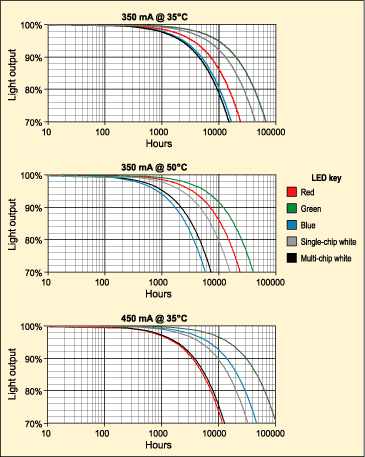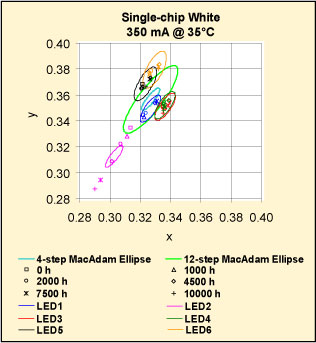
Benchmarking High-Flux LEDs: A Life Test
Ten years ago, LEDs were relegated to use as indicator lamps because of their small packages and high rates of lumen depreciation. But now, with the latest high-power and high-flux LEDs on the market, LEDs are progressing quickly toward use as general illumination.
 |
| Actual (to 10,000 hours) and estimated (beyond 10,000 hours) light output change over time for each LED type tested at each operating condition. The trend lines indicate approximately when each LED will reach 70% of initial light output. |

Color variations and color shift over time for six single-chip LEDs in one array. |
For any fixture and lamp, life is an issue. How long will a lamp continue to shine? At what point is its quality and quantity of light output no longer acceptable? Will the color stay constant? Although high-power LEDs generally perform better than previous types, each type and color of LED can perform differently. The LRC studied how LED characteristics change over time under various operating conditions.
The objective of this study was to evaluate currently available LED devices to develop a benchmark specification for state-of-the-art LED technology. These specifications include efficacy, color characteristics, and life (lumen maintenance). The long-range goal, however, is to develop metrics and life predictors that can be used by the lighting industry to quantify product performance.
EXPERIMENT
Five types of high-flux LEDs were operated for 10,000 hours: single-chip red, green, blue, and white LEDs, and a multiple-chip white LED. Each LED package contained several emitters. Three LED arrays of each type were mounted in specially designed life-test chambers and were operated at two drive currents and two ambient temperatures. Researchers measured lumen maintenance and color shift, and estimated LED junction temperature, a known predictor of LED life.
RESULTS
The LEDs degraded at different rates under similar operating conditions.
- Green and single-chip white LEDs degraded slowly, even under increased drive current and ambient temperature.
- Blue and multi-chip white LEDs showed the highest rates of degradation.
- Data extrapolation indicates that the single-chip white LED will maintain 70% of its initial light output at 45,000 hours.
- The individual white LEDs on each array exhibited large color variations from the beginning. However, their color shift over time was quite small.
In general, the degradation rate increased with higher junction temperatures. However, the relationship between junction temperature and degradation rate is still unknown.
FURTHER STUDY
LRC researchers are testing new high-flux LEDs from several manufacturers. Preliminary results indicate significant performance variations among the different manufacturers’ products. Researchers are also developing alternate life prediction methods to avoid long-term life testing.
PROJECT LINK
This study was part of a larger project funded by the U.S. Department of Energy: High-Efficiency, Nitride-Based Solid-State Lighting
SPONSOR
United States Department of Energy
Cooperative Agreement No. DE-FC26-01NT41203
University of California at Santa Barbara
|


